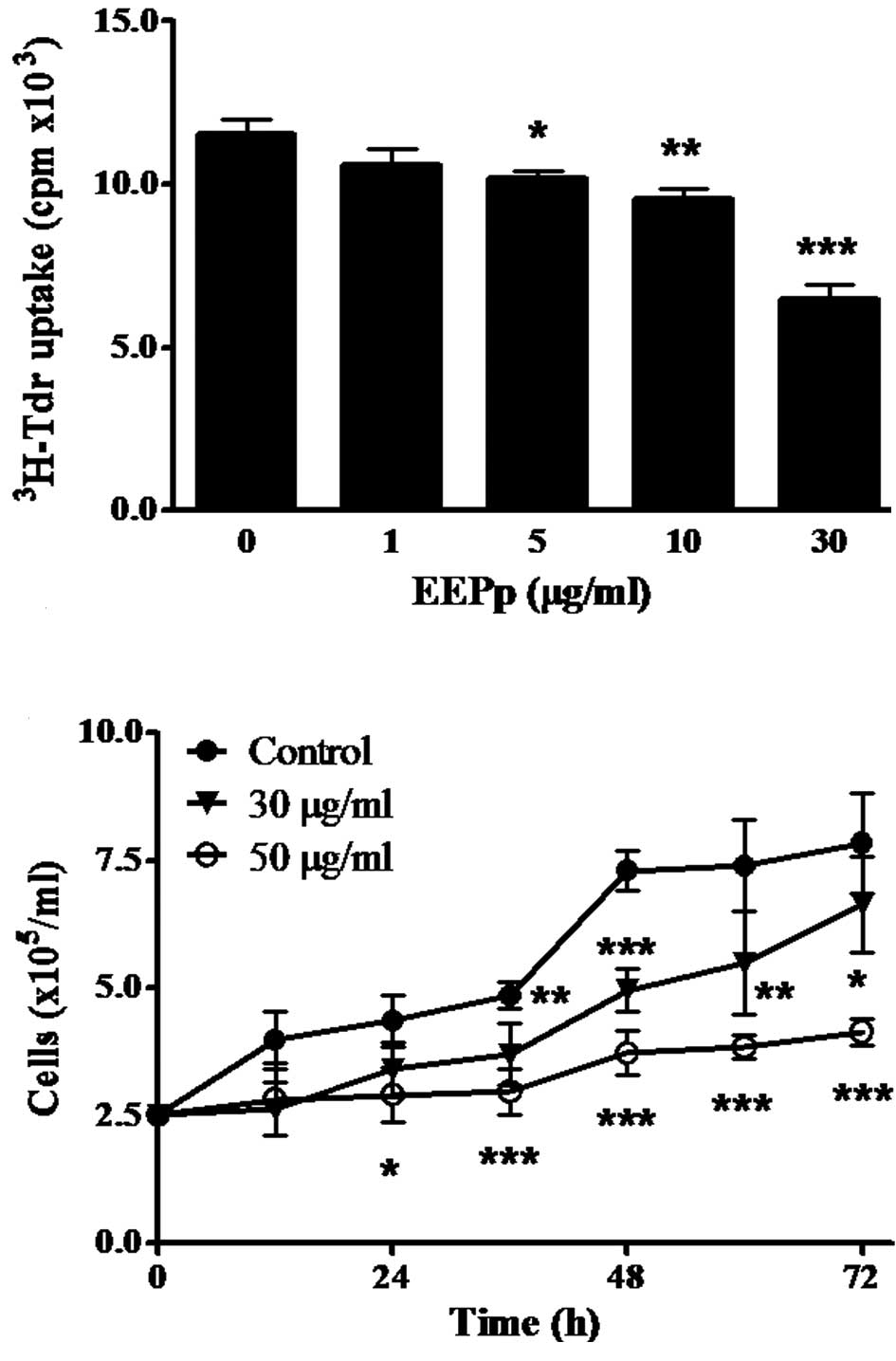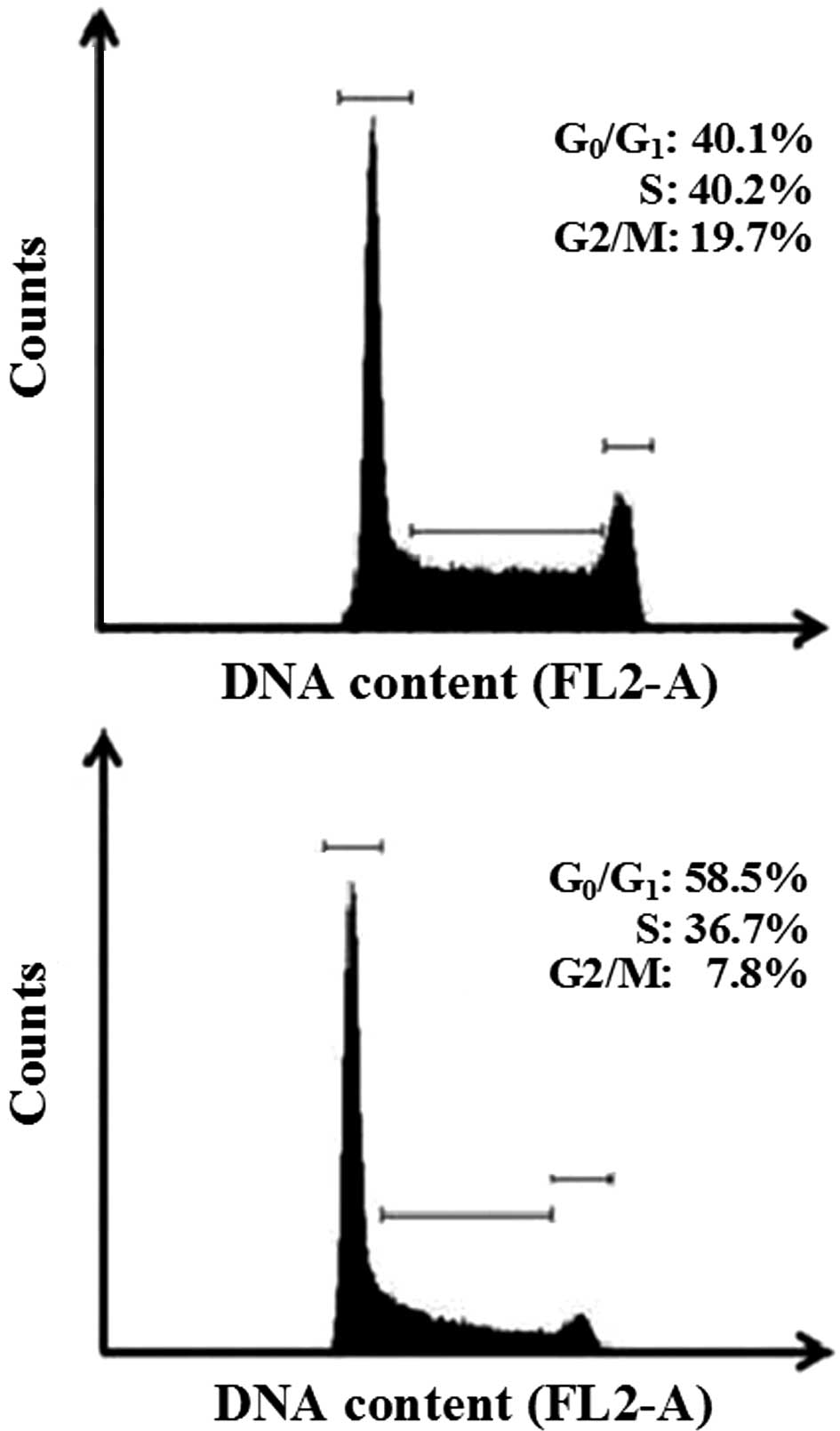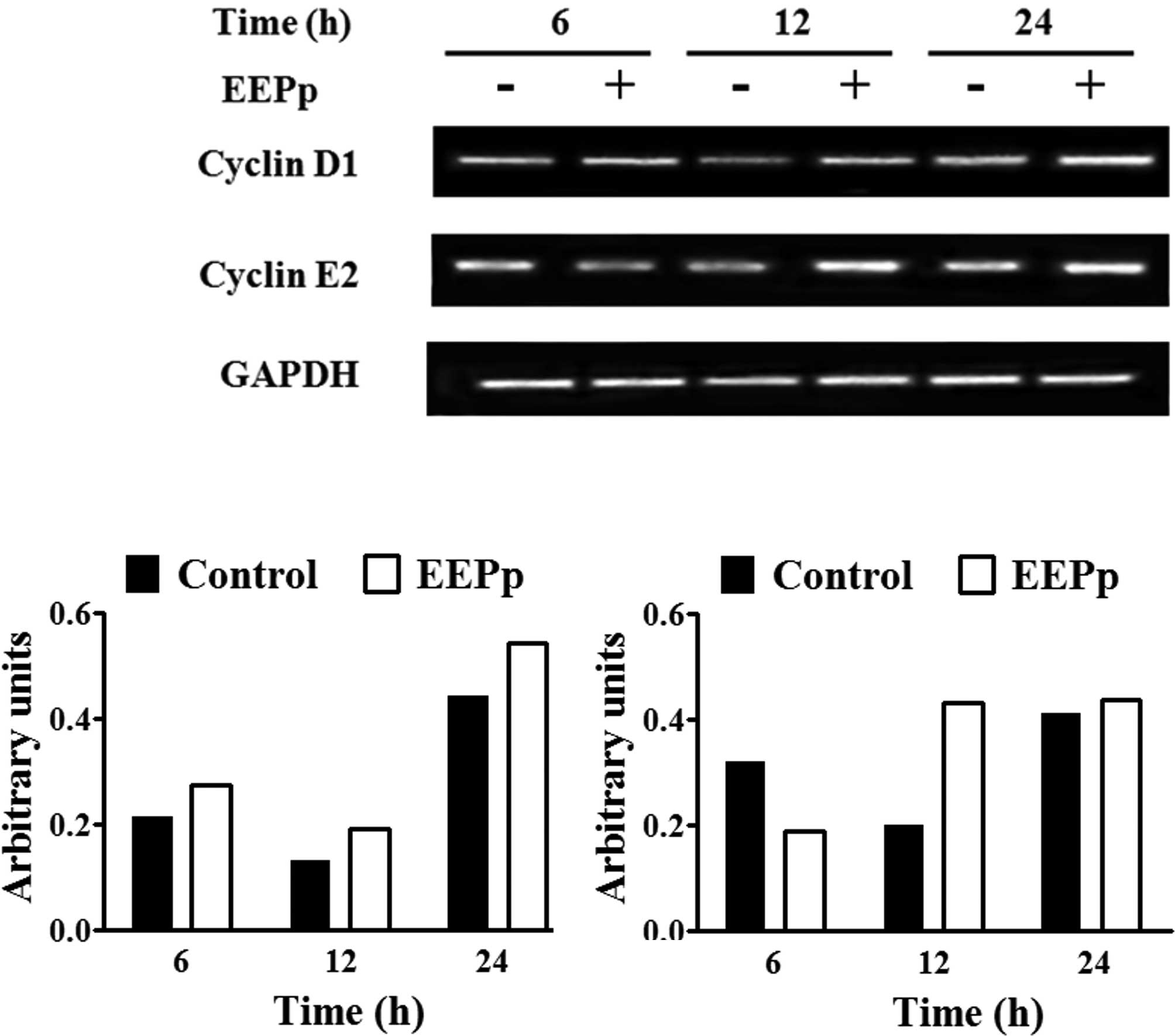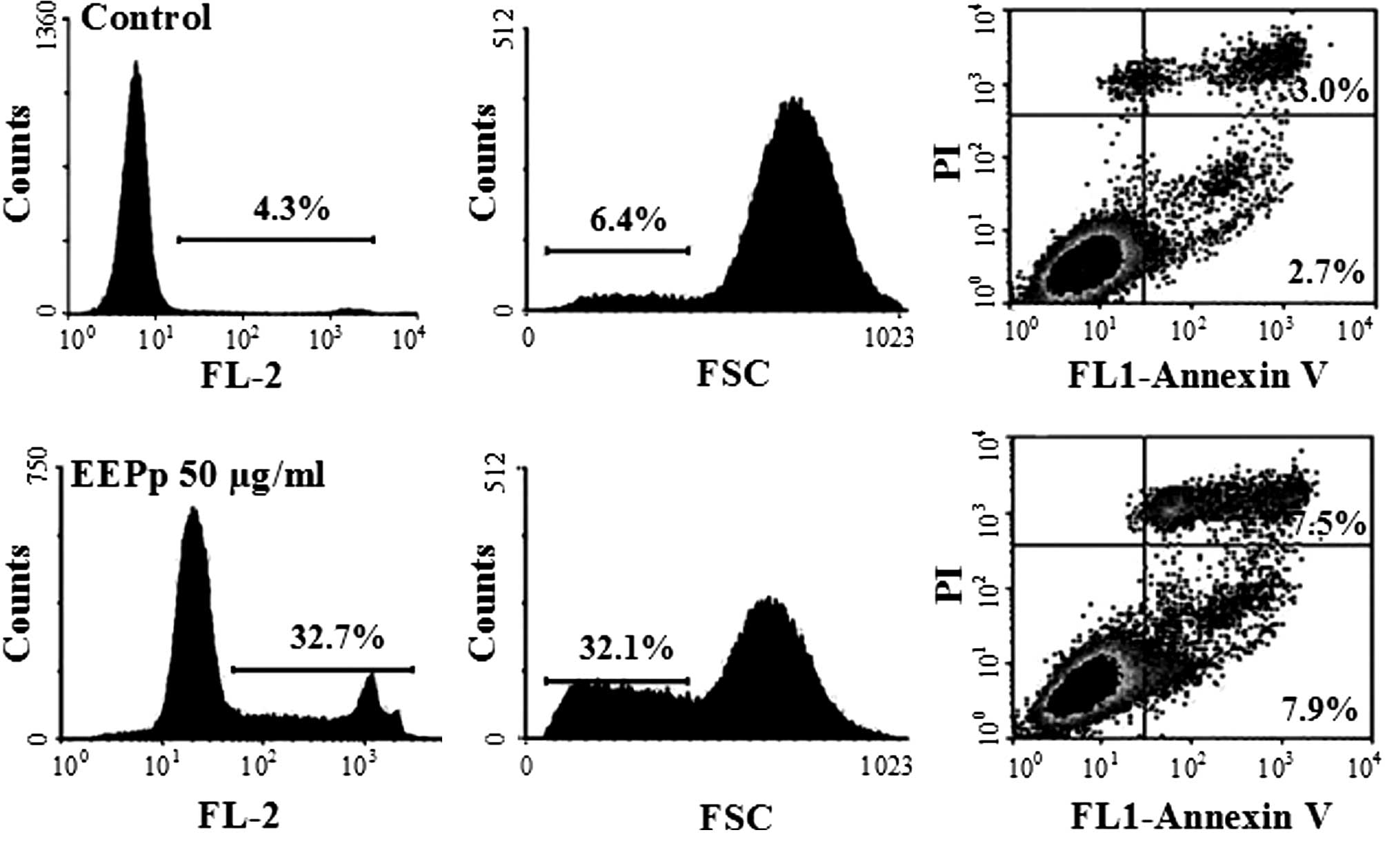Pterodon pubescens seed extract induces the cell cycle arrest of leukemic cells by deregulating cyclin D1 and E2 mRNA levels
- Authors:
- Published online on: May 1, 2010 https://doi.org/10.3892/ol_00000094
- Pages: 533-536
Abstract
Introduction
Cancer is the second leading cause of human mortality worldwide, and conventional therapies are known for their serious side effects. Therefore, many efforts have been made to determine novel alternative approaches for the prevention or treatment of cancer. Advances in cancer research have shown that alterations in the expression or function of genes that control the cell cycle and apoptosis enhance tumor survival through the disruption of the balance between these processes. Plants have been used as a source of anti-cancer agents since the 1950s, when the alkaloids vinblastine and vincristine were isolated from Catharanthus roseus G. Don. Chemotherapeutic agents in clinical use such as paclitaxel and flavopiridol (1) are also derived from plants.
Pterodon pubescens Benth. (Leguminosae-Papilionoidea) is popularly known as ‘Sucupira branca’, and its seeds are used in folk medicine to treat rheumatic and inflammatory diseases. Scientific data have confirmed the anti-arthritic effects of the hydroalcoholic extract of Pterodon pubescens seeds in type II collagen-induced arthritis in mice without subacute toxic effects (2–4). Although anti-inflammatory action has been noted for the seed ethanolic extract (EEPp) (5), anti-proliferative effects on leukemic cells have yet to be demonstrated. The present study showed that EEPp deregulates cyclin D1 and E2 mRNA expression by inducing cell cycle arrest in the G1 phase and apoptosis in the chronic myelogenous leukemia K562.
Materials and methods
Extract preparation
The seeds of Pterodon pubescens Benth. were collected by Luciana Pontes Coelho in Goiás, Brazil, and identified by Haroldo Cavalcante de Lima at the Jardim Botânico do Estado do Rio de Janeiro, Brazil, where a voucher was deposited (RB 350279). The powdered seeds were submitted to 100% ethanol (15 g/100 ml) for 15 days. Following ethanol evaporation, the viscous oil (EEPp) was obtained, yielding 50% (w/w). EEPp was dissolved in ethanol and then diluted with a supplemented medium consisting of RPMI-1640 with 10% fetal bovine serum (Cultilab, Brazil), penicillin (70 mg/l) and streptomycin (100 mg/l) to a final ethanol concentration of 0.01%. Control cultures received only 0.01% ethanol in the supplemented medium.
Cell growth
The human chronic myelogenous leukemia cell line K562 (CCL-243), purchased from the American Type Culture Collection, was always cultured (2.5×105 cells/ml) in the supplemented medium. For cell growth, the cell line was treated with 10, 30 or 50 μg/ml EEPp for 72 h at 37°C and 5% CO2. Viable cells (by trypan blue dye exclusion) were counted at a 12-h interval.
Cell proliferation assay
The cells were cultured in 96-well plates (200 μl) with different EEPp concentrations and 0.25 μCi/well [3H]-methyl-thymidine (Amersham Biosciences, Brazil) for 24 h at 37°C in 5% CO2. Subsequently, the cells were harvested on filter papers and processed for the determination of 3H-Tdr radioactivity using liquid scintillation.
Cell cycle analysis
Cells were cultured with 30 μg/ml EEPp for 36 h at 37°C in 5% CO2. After centrifugation (400 × g), 1×106 viable cells were treated with 0.3% Triton X-100 containing 50 μg/ml propidium iodide (PI) in 43 mM citrate buffer solution (pH 8.2) for 15 min in the dark, and then with 500 μl of 100 μg/ml ribonuclease A (Sigma Chemical Co., USA) for 15 min. PI fluorescence (585±15 nm) was measured (100,000 events) using a FACSCalibur cytometer (Beckton-Dickinson, USA), and data were analyzed using the WinMdi 2.8 software.
Analysis of apoptosis using flow cytometry
Cells were treated with 50 μg/ml EEPp for 36 h at 37°C in 5% CO2. Cell death was evaluated by the loss of membrane integrity (high PI fluorescence at 485 nm) after treatment with PI solution (final concentration 2 μg/ml). Apoptosis was determined by cell shrinkage (size reduction) and evaluated by the forward-scatter (FSC) parameter. Phosphatidylserine exposure was then determined using the Annexin V-FITC/PI double staining kit (BD Pharmingen, USA). Briefly, cells (1×105) were washed with PBS, suspended in binding buffer (10 mM HEPES pH 7.4, 140 mM NaCl and 2.5 mM CaCl2) and treated with Annexin V (5 μl) and 50 μg/ml PI solution (10 μl) for 15 min at room temperature. Annexin binding was determined by FITC fluorescence (535±15 nm). Cells (105/assay) were obtained using Cell Quest software and analyzed using WinMdi 2.8 software.
Analysis of mRNA expression using RT-PCR
Total RNA was extracted using TRIzol (Invitrogen). The reverse transcription reaction was performed by adding MMLV reverse transcriptase (Invitrogen), RNA and random primers to the reaction mixture. PCR was performed in a Perkin Elmer GeneAmp PCR System 9600. cDNA was added to a 25-μl PCR mixture containing dNTP, the specific primers and Platinum Taq DNA polymerase (Invitrogen). Each cycle consisted of 30 sec at 94°C, 30 sec at annealing temperature, and 1 min at 72°C. The PCR products were resolved on a 2% agarose-ethidium bromide gel and quantified by Lab Image software (Germany). The primers used were: GAPDH (housekeeping gene), forward 5′-TGTGAACGGATTTGGCCGTA-3′ and reverse 5′-TCGCTCCTGGAAGATGGTGA-3′ (58°C, 30 cycles, 200 bp); cyclin D1, forward 5′-CTGGCCATGAACTACCT GGA-3′ and reverse 5′-GTCACACTTGATCACTCTGG-3′ (59°C, 30 cycles, 482 bp) and cyclin E2, forward 5′-ATCCAGG CCAAGAAGAGGAAA-3′ and reverse 5′-GCACAAGGCAG CAGCAGTC-3′ (63°C, 32 cycles, 612 bp).
Statistical analysis
Significant differences between the two groups were assessed using Student’s t-test, with a level of significance set at p<0.05.
Results
This study reports on the effect of EEPp on the proliferation of K562 leukemic cells using different methods. The incorporation of 3H-Tdr to DNA was significantly inhibited after a 24-h incubation (Fig. 1A). This effect began at 5 μg/ml EEPp (p<0.05), reaching 44% inhibition at 30 μg/ml (p<0.001). EEPp also induced a concentration- and time-dependent cell growth inhibition (Fig. 1B). When cultures were treated with EEPp at 30 μg/ml, cell growth was only slightly inhibited, while intense and continuous inhibition levels (70–80%) were observed at 50 μg/ml.
The anti-proliferative effects of EEPp with regard to other cell cycle phases were also studied. The histograms in Fig. 2 show a nuclear PI fluorescence distribution that is proportional to the DNA content (FL2-A). EEPp at 50 μg/ml effectively arrested K562 cell cycle progression from the G1 to the S phase (Fig. 2, lower panel). Apoptotic bodies, nuclear fragments or nuclear doublets were eliminated from the analysis. In this representative experiment, 50 μg/ml EEPp induced a 45% increase in cells at the G1 phase, while cell numbers at the S and G2/M phases reciprocally decreased by 16 and 60%, respectively. These effects were confirmed by analyzing the mean of three independent experiments (data not shown). The relative number of cells at G0/G1, S and G2/M phases in the control cultures was 40.1±1.2, 40.2±1.1 and 18.7±0.9%, respectively. In the presence of 50 μg/ml EEPp these numbers changed to 60.2±2.5% (50% increase, p<0.01), 31.8±2.6% (21% reduction, p=0.054) and 7.9±0.1% (58% reduction, p<0.01), respectively.
Analysis of cyclin mRNA expression using RT-PCR is shown in Fig. 3A. Control cultures exhibited a reduction in cyclin D1 mRNA levels at 12 h and an increase at 24 h (Fig. 3B), similar to cyclin E2 mRNA levels (Fig. 3C). EEPp at 30 μg/ml induced a higher cyclin D1 mRNA expression at all of the times analyzed (Fig. 3B). This concentration caused a reduction in cyclin E2 expression at 6 h and an increase at 12 h (Fig. 3C).
Apart from inhibiting cell proliferation and inducing cell cycle arrest at the G1 phase, EEPp at 50 μg/ml also induced K562 cell death (Fig. 4A). An increase in the relative number of shrunken cells from 6.4 to 32% (Fig. 4B) indicated that EEPp induces leukemic cells into apoptosis, which was confirmed by the increase in Annexin V-positive cells from 5.7 to 15.4% (Fig. 4C).
Discussion
Many plant products have been found to possess chemotherapeutic activities both in vitro and in vivo (6). This study noted the anti-proliferative activity of EEPp on chronic myelogenous leukemia-derived K562 cells. EEPp inhibited DNA synthesis, cell growth and arrested the cell cycle at the G1 phase, similar to other plant extracts with anti-tumoral activity (6). This effect was not due to ethanol, since ethanol treatment of the control cultures did not alter the responses (data not shown). Vieira and collaborators reported the anti-proliferative activity of a crude ethanolic extract of Pterodon pubescens seeds against the human melanoma cell line SK MEL 37, but data were not presented (7).
Cyclins D1 and E2 activate specific cyclin-dependent kinases, inducing the cell cycle progression from the G1 to S phase. In contrast to conventional drugs which inhibit tumor cell line proliferation by reducing cyclin D1 mRNA levels, EEPp treatment increased it. Similar results have been reported for other cell lines (8). The reduction in cyclin E2 mRNA expression in tumor cells by EEEp treatment (6 h) has also been described for several anti-cancer agents (9).
Traditional chemotherapeutic agents and potential anti-cancer drugs (6) deregulate cell cycle components, triggering apoptosis in tumor cells. EEPp induced K562 cells into apoptosis despite their mutated TP53 tumor suppressor gene and resistance to several anti-cancer drugs (10), suggesting that this effect occurs through a p53-independent mechanism.
EEPp is a viscous, brown and fragrant oil, containing geranylgeraniol, farnesol, naphthalene, dimethyldodecatrienol and vouacapan diterpene derivatives (5,7). A vouacapan diterpene, isolated from a Pterodon pubescens extract, was shown to reduce proliferation and induce apoptosis of melanoma cells (7). The compounds geranylgeraniol and farnesol were shown to induce tumor cell anti-proliferative effects (11) and apoptosis (12,13). Thus, different substances present in EEPp may be involved in its anti-leukemic effects.
This study showed that the ethanolic extract of Pterodon pubescens seeds induced the cell cycle arrest and apoptosis of a resistant leukemic cell line and that the deregulation of D1 and E2 cyclin mRNA expression may be related to these anti-proliferative effects. The fractionation of this extract as well as experiments to clarify other mechanisms involved in the anti-leukemic effects of EEPp are currently in progress.
Acknowledgements
We thank the LIA-BPPN Laboratory personnel for their technical assistance. This study was supported by FAPERJ (E-26/171.330/2006).
References
|
Cragg GM and Newman DJ: Plants as a source of anti-cancer agents. J Ethnopharmacol. 100:72–79. 2005.PubMed/NCBI | |
|
Sabino KCC, Castro FA, Oliveira JCR, Dalmau SRA and Coelho MGP: Successful therapy of collagen-induced arthritis in mice with a hydroalcoholic extract of seeds of Pterodon pubescens. Phytother Res. 13:613–615. 1999. View Article : Google Scholar : PubMed/NCBI | |
|
Coelho MGP, Marques PR, Gayer CRM, Vaz LCA, Nogueira Neto JF and Sabino KCC: Subacute toxicity evaluation of a hydroalcoholic extract of Pterodon pubescens seeds in mice with collagen-induced arthritis. J Ethnopharmacol. 77:159–164. 2001. View Article : Google Scholar : PubMed/NCBI | |
|
Coelho MGP, Sabino KCC and Dalmau SR: Immunomodulatory effects of sucupira (Pterodon pubescens) seed infusion on collagen-induced arthritis. Clin Exp Rheumatol. 22:213–218. 2004. | |
|
Silva MC, Gayer CR, Lopes CS, et al: Acute and topic anti-edematogenic fractions isolated from the seeds of Pterodon pubescens. J Pharm Pharmacol. 56:135–141. 2004. View Article : Google Scholar : PubMed/NCBI | |
|
Reddy L, Odhav B and Bhoola KD: Natural products for cancer prevention: a global perspective. Pharmacol Ther. 99:1–13. 2003. View Article : Google Scholar : PubMed/NCBI | |
|
Vieira CR, Marques MF, Soares PR, et al: Antiproliferative activity of Pterodon pubescens Benth. seed oil and its active principle on human melanoma cells. Phytomedicine. 15:528–532. 2008. | |
|
Okabe H, Lee SH, Phuchareon J, Albertson DG, McCormick F and Tetsu O: A critical role for FBXW8 and MAPK in cyclin D1 degradation and cancer cell proliferation. PLoS ONE. 1:e1282006. View Article : Google Scholar : PubMed/NCBI | |
|
Diaz-Carballo D, Malak S, Freistühler M, Elmaagacli A, Bardenheuer W and Reusch HP: Nemorosone blocks proliferation and induces apoptosis in leukemia cells. Int J Clin Pharmacol Ther. 46:428–439. 2008. View Article : Google Scholar : PubMed/NCBI | |
|
Pytel D, Wysocki T and Majsterek I: Comparative study of DNA damage, cell cycle and apoptosis in human K562 and CCRF-CEM leukemia cells: role of BCR/ABL I therapeutic resistance. Comp Biochem Physiol. 144:85–92. 2006.PubMed/NCBI | |
|
Miquel K, Pradines A, Tercé F, Selmi S and Favre G: Competitive inhibition of choline phosphotransferase by geranylgeraniol and farnesol inhibits phosphatidylcholine synthesis and induces apoptosis in human lung adenocarcinoma A549 cells. J Biol Chem. 40:26179–26186. 1998. View Article : Google Scholar | |
|
Masuda Y, Nakaya M, Aiuchi T, Hashimoto S, Nakajo S and Nakaya K: The mechanism of geranylgeraniol-induced apoptosis involves activation, by a caspase-3-like protease, of a c-Jun N-terminal kinase signaling cascade and differs from mechanisms of apoptosis induced by conventional chemotherapeutic drugs. Leuk Res. 24:937–950. 2000. View Article : Google Scholar | |
|
Rioja A, Pizzey AR, Marson CM and Thomas NS: Preferential induction of apoptosis of leukaemic cells by farnesol. FEBS Lett. 467:291–295. 2000. View Article : Google Scholar : PubMed/NCBI |













